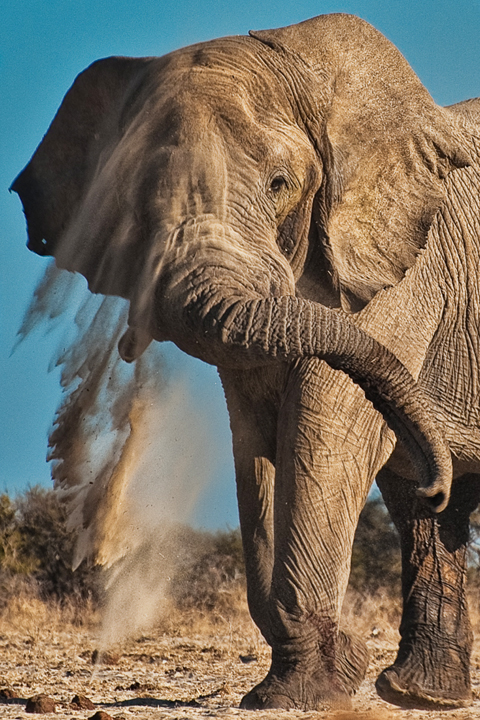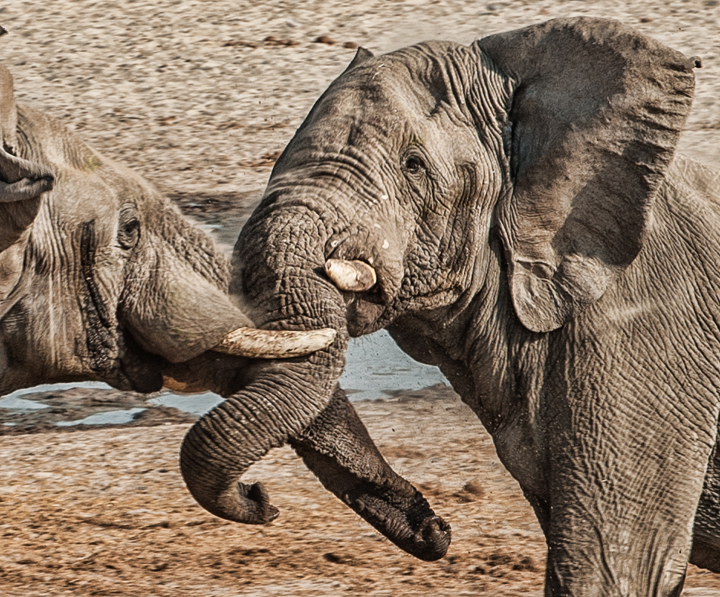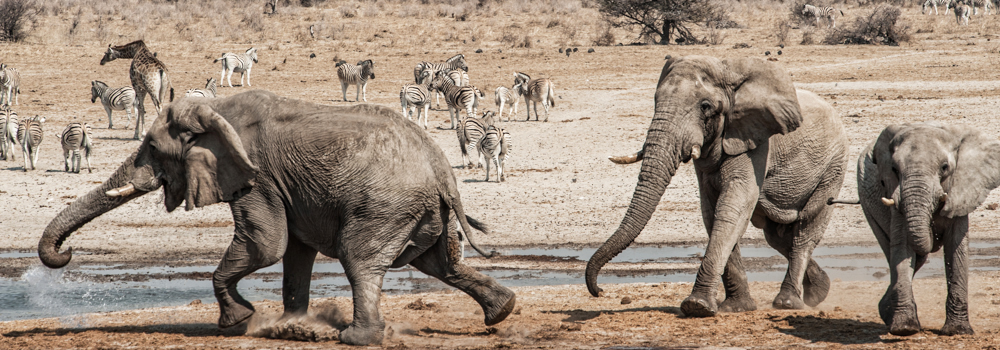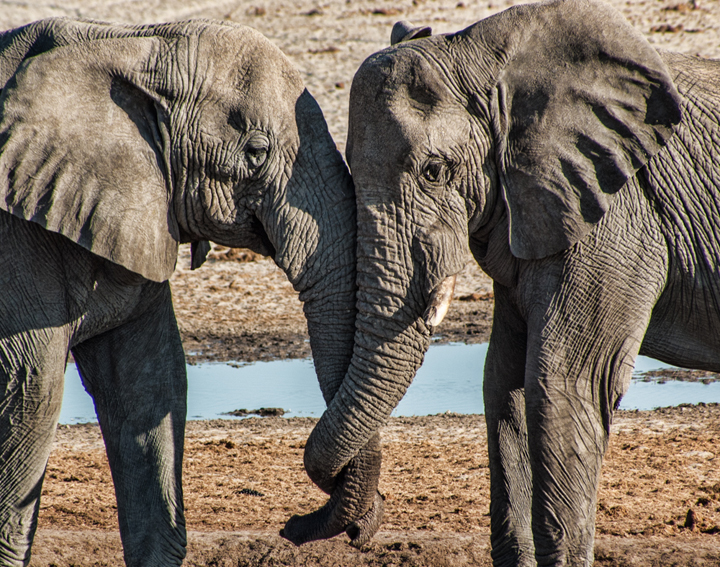How To Speak Elephant
From a trunk-in-the-mouth “I’m sorry” to a head-shaking “Don’t you dare!” Caitlin O’Connell decodes the body language of elephants.
By Vicki Croke
Elephants “kind of wear their hearts on their trunks. Their trunks are extremely expressive of their mood,” says Caitlin O’Connell. She should know. By closely observing elephants at Etosha National Park in Namibia part of each year for the past 20 years, O’Connell has become bilingual in a way. Each gesture, ear flap, trunk poke, and even penis pose can convey meaning. If you know what to look for.

Caitlin O’Connell’s latest book offers a rare glimpse inside the world of male elephants. Her work of fiction (an Ebook mystery), “Ivory Ghosts” is just out too. Book cover photo: Caitlin O’Connell and Timothy Rodwell.
And O’Connell knows what to look for. Lucky for us, she’s willing to clue us in. In her latest book, “Elephant Don: The Politics of a Pachyderm Posse,” just out this month, the gifted translator of all things elephant, provides a front row seat on a long-running soap opera, which has been cast with some very big stars.
From two observation areas overlooking a reliable water source, O’Connell, a faculty member at Stanford University, watches a steady stream of towering animals as they arrive and interact. By night, the family groups, made up of experienced females with their sisters, daughters, and children, come to drink.
But the days belong to the big boys: The males, who arrive alone or in groups, to meet, greet, drink, play, insult each other, challenge each other, test loyalties, fight, and even forgive.
So much of elephant research concerns matriarchs and the family groups they lead. O’Connell is one of the few researchers to focus on male elephants, and her work has proved that they are much more social and interactive than was thought before.

Caitlin O’Connell photographing her elephants at the Mushara water hole in Etosha National Park in Namibia. Photo: Caitlin O’Connell and Timothy Rodwell.
Being the top elephant and staying there isn’t easy. It requires bulk, strength, social smarts, political strategizing, and sometimes luck. O’Connell teaches us this by telling the story of the reigning king, Greg, and his pals, rivals, and neighbors, including Kevin, Mike (the gentle giant), Congo Conner, Prince Charles, Willie Nelson, Stoly, Abe, and Dave. We get to know these characters as we do family or friends. They feel familiar because O’Connell’s body language translations create nuanced portraits of each animal, illuminating the distinct personality of each.
Take the way she describes one of my favorites from the book—a young bull named Congo. When we first meet him, he arrives “with trunk swinging as loose as a slinky.” The super laid-back youth has “baggy skin around his knees” and walks with a “shuffling gait.” It makes him look like “a kid in unlaced high-top sneakers, with baggy jeans dragging on the ground.”
Later, we see him action, meeting up with his old pals:
“Congo then said hello to Willie. First he placed his trunk in Willie’s mouth and, after that, he held onto Willie’s magnificent up-curved tusk with his trunk and leaned in as if giving him a slap on the back while shaking hands. He definitely had a flare to his greetings—like a surfer dude or a skateboarder, holding his trunk out to his buddies for a high five after coming off a great halfpipe.”
In an attempt to gain some fluency myself, I called O’Connell by phone to ask for a key to some of the every-day but grand gestures of elephants.
How does an elephant say hello?
“It’s just like a handshake. They place their trunk in the other one’s mouth and say hello.”
What’s an elephant insult?
“An elephant has a number of ways of insulting another elephant,” O’Connell says, but one of the strongest is:
They hold their head high and their ears straight out like wings
And then they shake their massive heads— sending up clouds of dust off their skin as they do so and making a cracking noise with their flapping ears. Spectacular.
How about a threat?
“They’ll hold their ears out and head up and run at the other elephant, and then stop short, and then stamp their feet. That would be a mock charge…A really serious threat would be to just keep going and actually have contact with the other elephant.”
An elephant apology:
An apology is like the hello—a trunk placed in another’s mouth. But, with an apology, there’s usually an offended or angry elephant involved. Because of that, O’Connell says, “it’s often done with some trepidation. You can see that the trunk is quivering a little bit, the tip is quivering. They’re a little bit nervous. It’s kind of risky. They’re going to say ‘I’m sorry,’ and place their trunk in the other one’s mouth.”
How does an elephant express uncertainty?:
“They will actually take the tip of their trunk and put it in their mouth and suck it, kind of like sucking a thumb.”
What does a frightened elephant look like?
“They will lower their posture. Their whole profile goes down, like a crouch. Their back is low, their head is low, everything is low. That indicates that they’re afraid. And it’s just the opposite when they’re aggressive. They puff up and stand as high as they possibly can…and hold their head high. So you can see the opposite in one that’s threatening another. One would be standing really tall and the other would be crouched down.”
What does a happy elephant look like?
“A happy elephant is really fun to watch. Very similar to a dog. They’ll sort of bounce around on their feet and their front feet especially will sort of prance and their trunk will swing. They kind of have this bounce to their stride.”







One Response to “How To Speak Elephant”
Great descriptions of the communications and interactions of these incredibly intelligent animals. When given the insight of those such as Caitlin who have the ability and awareness to discern the interactions, and share them so well, one can only wonder how we can allow these magnificent animals in circuses and other inappropriate captive conditions.
Comments are closed.